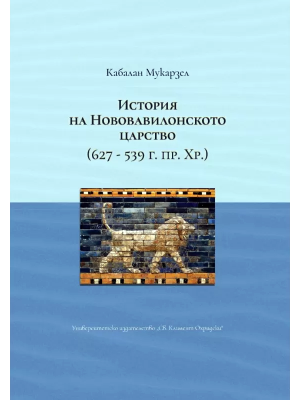Shopping Cart
0 item(s) - 0.00лв
Authority and Ideology in the Early Neo-Assyrian Empire (934–745 B.C.)
Zozan Tarhan. Authority and Ideology in the Early Neo-Assyrian Empire (934—745 B.C.)
Власт и идеология в Ранната новоасирийска империя (934—745 г. пр.Хр.)
Language: Bulgarian with a summary in English
Category: Mesopotamia
This monograph is on the topic of successfully depended PhD dissertation. The book examines the royal authority and ideology in the Early Neo-Assyrian Empire (934—745 B.C.). Its aims can be summarized as follows:
1. Study of the reign of each Assyrian king of the period, his military and political actions, including the dynamics of contacts with the countries of the region, the goals pursued by him; and — for whom applicable — the relevant internal affairs and building activities;
2. Study of the Assyrian royal ideology in the context of certain motives, beliefs, and suggestions attested in the sources;
3. Concluding observations on and synthesis of the exercise of authority, which led to the historical processes and political contacts in combination with the motives, beliefs, and suggestions of the Assyrian royal ideology.
Table of contents
Introduction
I. Sources
I.1. Written Sources
Royal inscriptions
limmu lists
Chronicles
King lists
Ritual and cultic texts
Literary sources
Other sources
I.2. Archaeological and Iconographic Sources
II. Historical Expose of Assyria before Neo-Assyrian Period: Some marks on the Development of the Royal Authority and Ideology
II.1. Assyria during the Old Assyrian Period (ca. 2004—1736 B.C.) II.2 Assyria during the Middle Assyrian Period (1353—935 B.C.)
III. The Authority in the Early Neo-Assyrian Empire
III.1. Aššur-dān II (934—912 B.C.)
Military campaigns on the west/northwest
Military campaign on the north/northeast
Military campaign in indeterminable direction
Building activities and renovations
Summary and concluding remarks
III.2. Adad-nērārī II (911—891 B.C.)
Military campaigns
Building activity
Summary and concluding remarks
III.3. Tukultī-Ninurta II (890—884 B.C.)
Military campaigns
Building activity
Summary and concluding remarks
III.4. Ashurnasirpal II (883—859 B.C.)
Foreign policy. Military campaigns
Internal affairs and building activity
Summary and concluding remarks
III.5. Shalmaneser III (858—824 B.C.)
Foreign policy. Military campaigns
The rebellion
Building activity
Summary and concluding remarks
III.6. Šamšī-Adad V (823—811 B.C.)
Foreign policy. Military campaigns
Summary and concluding remarks
III.7. Adad-nērārī III (810—783 B.C.)
III.8. The Heirs of Adad-nērārī III (782—745 B.C.)
III.9. Institutions and officials
IV. The Ideology in the Early Neo-Assyrian Empire
IV.1. What is an (Assyrian) Ideology?
IV.2. The King, Chosen by the Gods
Titulary and epithets
The Call
The Coronation Ritual
Summary and concluding remarks
IV.3. The Role of the King as а Priest
The king as a priest in the royal inscriptions
The king as a priest in the iconographic sources
The king as a priest in the ritual texts
Summary and concluding remarks
IV.4. The King as a Conqueror. The Imperial Mission
IV.5. The King, Who Has No Rival
IV.6. The Personal Palace and Iconographic Sources as a Mark of the Kingship
Conclusion
Bibliography
Acknowledgements
Abstract
Appendices
Glossary of the Terms
Titles and offices
Standard Mesopotamian Calendar
Table
Maps
Plans
Images
| Details | |
| Publisher | Gutenberg |
| Language | Bulgarian with summary in English |
| Pages | 360 |
| Illustrations | b/w figures |
| Binding | paperback |
| ISBN | 978-619-176-205-7 |
| Creation date | 2022 |
| Size | 16 x 24 cm |
Write a review
Your Name:Your Review: Note: HTML is not translated!
Rating: Bad Good
Enter the code in the box below:










